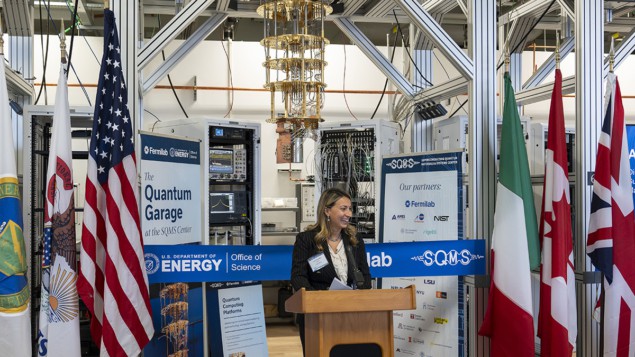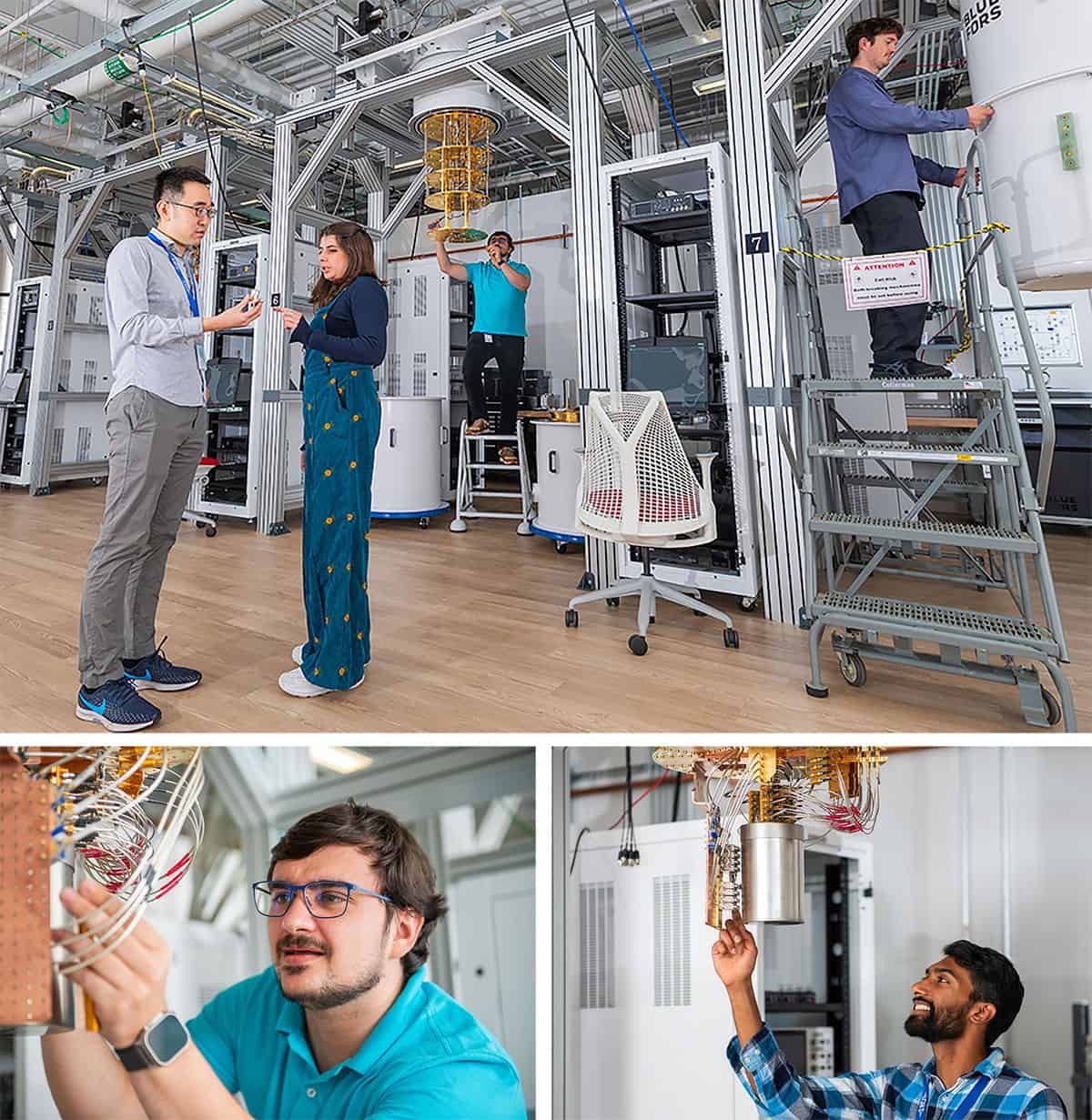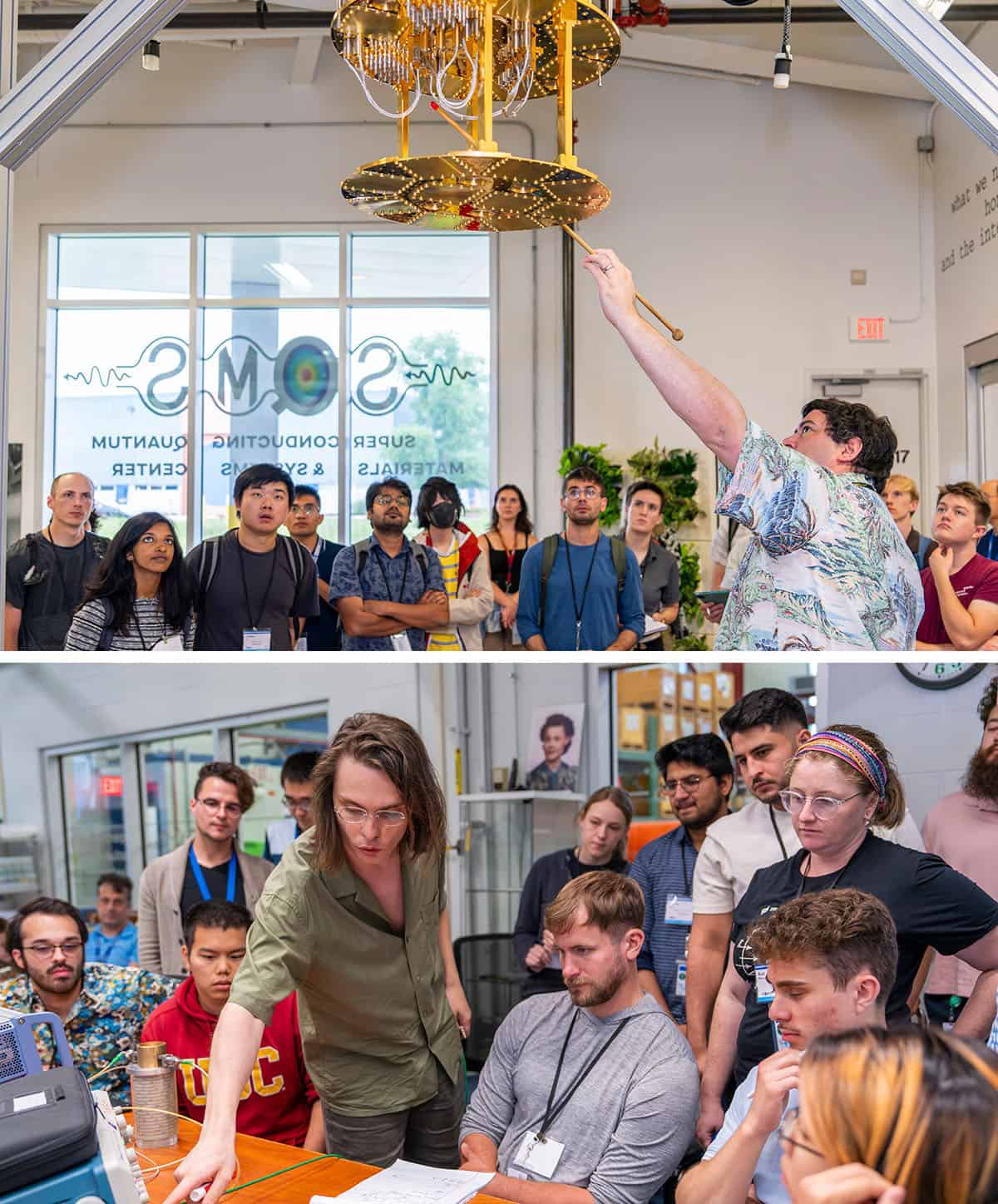The US Superconducting Quantum Materials and Systems (SQMS) Center is building on a portfolio of enabling technologies pioneered at Fermilab to realize practical applications of quantum computing and quantum sensing. SQMS director Anna Grassellino tells Joe McEntee why cross-disciplinary collaboration within the National Laboratory framework is fundamental to success

Anna Grassellino is a physicist in a hurry. As leader of a $125m quantum science programme, her remit is to implement an R&D roadmap that could be worth billions of dollars for the US tech industry via the development of superconducting materials and devices for next-generation quantum computers.
A specialist in RF superconductivity, Grassellino is director of the Superconducting Quantum Materials and Systems (SQMS) Center at Fermi National Accelerator Laboratory, the pre-eminent US particle physics facility on the outskirts of Chicago, Illinois. Funded to the tune of $25m a year through its initial five-year programme (2020–25), SQMS is one of five dedicated research centres focused on quantum information science within the US Department of Energy (DOE) National Laboratory system (see “The DOE Office of Science: betting big on quantum”, below).
The DOE and SQMS end-game: to develop and deploy practical quantum computers and quantum sensors with the potential for at-scale scientific, industrial and commercial adoption.
Prioritizing collaboration
Towards that goal, SQMS brings together a multidisciplinary collaboration of more than 500 scientists and engineers from 30 partner institutions – national labs, universities and businesses in the US and beyond – to address “all the pieces of the quantum puzzle”, according to Grassellino. Think applied and theoretical superconductivity, computational science, high-energy and condensed-matter physics, cryogenics, microwave devices and control engineering – with all this collective effort aligned squarely towards the translation and application of quantum science and technology.
With these highly coherent qubits, more complex quantum computing operations will ultimately become possible
Anna Grassellino
One of the fundamental problems preoccupying SQMS researchers is quantum coherence – or how to preserve the lifetimes of fragile quantum states for as long as possible (seconds rather than milliseconds or microseconds). “By using superconductors cooled to cryogenic temperatures,” says Grassellino, “we create environments where microwave photons can have long lifetimes and protection from external perturbations. These conditions make it possible to generate quantum states, manipulate them and read them out. With these highly coherent superconducting qubits, more complex quantum computing operations will ultimately become possible.”
While Grassellino still works closely with front-line scientists and engineers – overseeing work in the lab – her schedule is increasingly allocated in other directions – engaging with funding agencies and research partners, for example, while ensuring SQMS R&D projects remain on track versus DOE milestones and deliverables. “What I really enjoy is that there’s no typical day as SQMS director,” she says. “Every day is different.”
Scaling up the facilities
During the first three years of SQMS, the operational priority for Grassellino and her management team was clear: to scale up the quantum R&D infrastructure within Fermilab. The so-called “Quantum Garage” – a roughly 560 square-metre SQMS laboratory that launched formally at the beginning of November 2023 – is a case in point. On one level, the Quantum Garage is an exercise in capacity-building, with a fleet of six additional dilution refrigerators (previously there were just two) now online and providing cryogenic cooling to support SQMS experimental programmes and test, measurement and characterization of superconducting devices and subsystems.

However, the Quantum Garage is about much more than experimental capacity and research throughput. “The new facility has enabled us to launch a series of unique quantum R&D testbeds,” notes Grassellino. “Those testbed activities include granular studies of superconducting qubits and quantum computing processors as well as the development of high-coherence quantum sensors to support Fermilab’s fundamental physics programme – searching for particles beyond the Standard Model, for example, as well as dark-matter candidates and gravitational waves.”
Along another coordinate, the Quantum Garage provides the infrastructure and personnel for so-called “round robins” – essentially the exchange of quantum materials, devices and subsystems among R&D partners in the SQMS network to ensure the adoption of standardized test and measurement protocols and quality-assurance chains. “Our colleagues at standards labs like the US National Institute for Standards and Technology (NIST) and the National Physical Laboratory (NPL) in the UK are crucial to the success of this work package,” notes Grassellino.
A related initiative – the National Nanofabrication Taskforce – aims to enhance and standardize the SQMS effort in nanomaterials processing. Within the taskforce, four SQMS partners – Fermilab, NIST, Northwestern University and Rigetti Computing – are working together on a continuous improvement programme for device-level fabrication.
“This is a really productive, hand-in-hand collaboration,” notes Grassellino. “We’ve got SQMS researchers and engineers visiting each other’s clean-room facilities, exchanging materials ‘recipes’ and specialist know-how along the way.”
What’s more, the taskforce has already registered success by reproducibly increasing coherence times of superconducting qubits (more than a factor of two) across three of the sites – Fermilab, Rigetti and NIST. The key here is an SQMS-pioneered surface encapsulation technique that prevents the formation of surface dielectrics (which are highly detrimental to qubit performance).
The DOE Office of Science: betting big on quantum
The SQMS Center is one of five national quantum information science centres funded by the US DOE Office of Science. Like SQMS, each of the other four centres has its own network of industry, academic and National Laboratory partners.
- Quantum Systems Accelerator (QSA) is led by Lawrence Berkeley National Laboratory (Berkeley, CA) with Sandia National Laboratories (Albuquerque, NM) as lead partner. QSA works on co-designing algorithms, quantum devices and engineering solutions to deliver “quantum advantage in scientific applications”.
- Q-NEXT is led by Argonne National Laboratory (Lemont, IL) and is working with partners to create two national foundries for quantum materials and devices. Q-NEXT’s remit also includes secure quantum communications, quantum sensing networks and the establishment of quantum simulation and network testbeds.
- Quantum Science Center (QSC) is led by Oak Ridge National Laboratory (Oak Ridge, TN) and is designing materials that enable topological quantum computing (based on quasiparticles and 2D systems); implementing new quantum sensors to characterize topological states and detect dark matter; and designing quantum algorithms and simulations to investigate quantum materials, quantum chemistry and quantum field theories.
- Co-design Center for Quantum Advantage (C2QA) has a five-year goal to deliver a x10 improvement in software optimization, underlying materials and device properties, and quantum error correction; also to ensure these improvements combine to provide a x1000 improvement in appropriate metrics for quantum computation and communication. The programme is led by Brookhaven National Laboratory (Upton, NY).
Quantum education and training
The Quantum Garage is also the centrepiece for SQMS efforts to scale the specialist quantum workforce. Back in August 2023, for example, nearly 150 delegates, drawn from 70 organizations, spent 10 days at Fermilab attending the first US Quantum Information Science (USQIS) School. The aim of the school, which will be held annually, is to develop the next generation of quantum scientists, engineers and technicians by sharing theoretical knowledge and experimental skills through a mix of lectures, lab time, panel discussions and poster sessions.

Participants in the inaugural school came with a broad range of experience and backgrounds, including undergraduate and graduate students, educators, as well as scientific and technical staff from federal labs and industry. While the school was organized and hosted by SQMS, the lectures and training were very much a collective effort, involving close to 50 expert instructors from all five DOE Office of Science quantum research centres. (In that same spirit, the baton for the 2024 school now passes to the Quantum Science Center at Oak Ridge National Laboratory in Tennessee.)

QUANT-NET’s testbed innovations: reimagining the quantum network
“With the USQIS school, we’re offering a quantum education programme that gives participants an interactive, hands-on learning experience – the likes of which is currently out of reach for many interested in the rapidly expanding field,” notes Grassellino. In particular, the school exposes attendees to sophisticated enabling technologies – including qubit control systems, high-capacity dilution refrigerators and nanofabrication clean rooms – none of which are routinely found in a typical university setting. “It’s this mix of deep expertise and cutting-edge infrastructure that make the National Laboratories the ideal channel for this sort of specialist training and development,” adds Grassellino.
With encouraging progress evident along multiple SQMS fronts, Grassellino is already turning her attention to the next five-year funding cycle for the DOE’s quantum information science initiative. The DOE’s proposed renewal – currently under review in Congress – would see SQMS funding potentially boosted for the 2025-30 cycle.
“SQMS is already a success,” concludes Grassellino. “Three years ago, we had an empty facility; now we have a fully kitted-out Quantum Garage. Over the same time, we have created an international collaboration of leading experts, trained up more than 500 students and postdocs in many areas of quantum science and engineering, while maintaining our laser focus on the core mission: increasing the coherence of superconducting qubits in a systematic manner.”
- SEO Powered Content & PR Distribution. Get Amplified Today.
- PlatoData.Network Vertical Generative Ai. Empower Yourself. Access Here.
- PlatoAiStream. Web3 Intelligence. Knowledge Amplified. Access Here.
- PlatoESG. Carbon, CleanTech, Energy, Environment, Solar, Waste Management. Access Here.
- PlatoHealth. Biotech and Clinical Trials Intelligence. Access Here.
- Source: https://physicsworld.com/a/fermilabs-sqms-center-addresses-all-aspects-of-the-quantum-puzzle/



